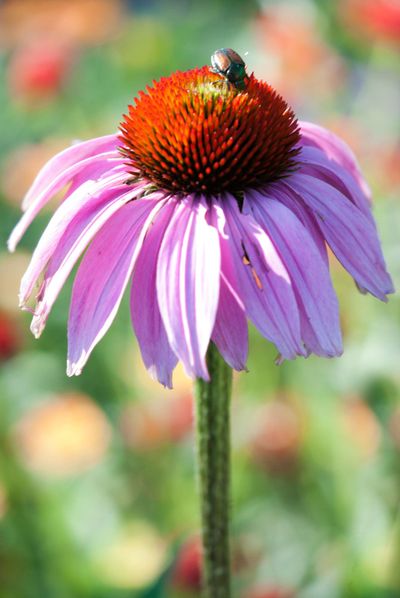Coneflower Pests
The most common insect pests that affect coneflowers include sweet potato whiteflies, aphids, Japanese beetles, and Eriophyid mites.
Sweet potato whiteflies – Sweet potato whiteflies live and feed on the undersides of leaves, sucking out plant juices. Oftentimes, the presence of these pests results in the growth of black sooty mold. In addition, you may see leaf yellowing and shredding. Sweet potato whiteflies can also transfer diseases, such as vector viruses. Aphids – Aphids, like whiteflies, will suck the nutrients from plants. In large masses, they can quickly overwhelm and kill plants. Japanese beetles – Japanese beetles feed in groups and can usually be spotted around June. They will quickly destroy plants by feeding on foliage and flowers, starting at the top and working down. Eriophyid mites – Eriophyid mites live and feed on the insides of flower buds. Damage can be recognized by stunted growth and distorted flowers.
Treatment of these insect pests can usually be achieved with insecticidal soap sprays, handpicking beetles, and the removal of affected plant parts. In addition to insects, coneflowers can also be attacked by rabbits. This is usually more of a problem on young plants, however, as rabbits thoroughly enjoy the young shoots and seedlings. Hot pepper wax sprays can oftentimes deter rabbit damage by making the foliage less appealing.
Coneflower Plant Diseases
Stem rot, powdery mildew, and aster yellows are the most common coneflower diseases.
Stem rot – Stem rot normally results from overwatering, as these plants are quite tolerant of drought-like conditions and require less watering than many other plants. Powdery mildew – Problems with powdery mildew usually occur due to overly moist conditions and lack of airflow. This can be easily avoided by providing adequate air circulation proper spacing as well as keeping moisture to a minimum. Aster yellows – Aster yellows is a disease that is most often transmitted through insects or poor growing conditions that make plants more susceptible. Flowers become distorted, turn green in color, exhibit stunted growth, and may even die. Infected plants should be removed and destroyed.
While issues with coneflowers rarely occur, you can easily avoid most coneflower problems by planting them in well-draining soil and providing them with adequate growing room. Good watering practices should also be used.
